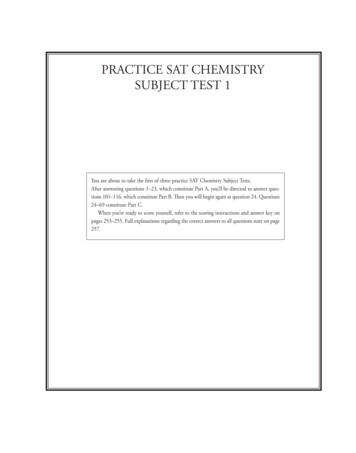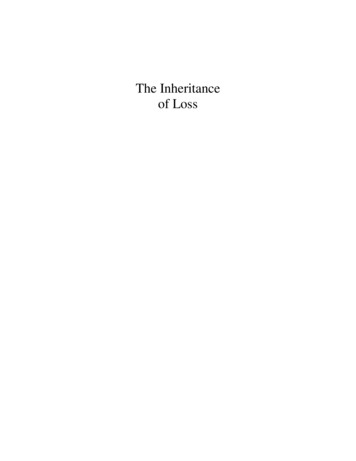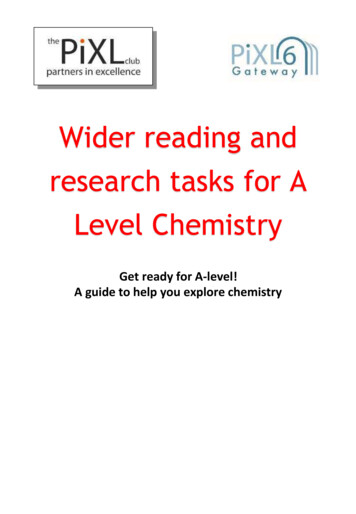
Transcription
The ExamAP Chemistry ExamSECTION I: Multiple-Choice QuestionsDO NOT OPEN THIS BOOKLET UNTIL YOU ARE TOLD TO DO SO.At a GlanceTotal Time1 hour and 30 minutesNumber of Questions60Percent of Total Grade50%Writing InstrumentPencil requiredInstructionsSection I of this examination contains 60 multiple-choice questions. Fill in only the ovals fornumbers 1 through 60 on your answer sheet.CALCULATORS MAY NOT BE USED IN THIS PART OF THE EXAMINATION.Indicate all of your answers to the multiple-choice questions on the answer sheet. No creditwill be given for anything written in this exam booklet, but you may use the booklet for notesor scratch work. After you have decided which of the suggested answers is best, completelyfill in the corresponding oval on the answer sheet. Give only one answer to each question. Ifyou change an answer, be sure that the previous mark is erased completely. Here is a samplequestion and answer.Sample QuestionChicago is a(A) state(B) city(C) country(D) continentSample AnswerABCDUse your time effectively, working as quickly as you can without losing accuracy. Do notspend too much time on any one question. Go on to other questions and come back to theones you have not answered if you have time. It is not expected that everyone will know theanswers to all the multiple-choice questions.About GuessingMany candidates wonder whether or not to guess the answers to questions about whichthey are not certain. Multiple choice scores are based on the number of questions answeredcorrectly. Points are not deducted for incorrect answers, and no points are awarded forunanswered questions. Because points are not deducted for incorrect answers, you areencouraged to answer all multiple-choice questions. On any questions you do not know theanswer to, you should eliminate as many choices as you can, and then select the best answeramong the remaining choices.DisclaimerThis test is an approximation of the test that you will take. For up-to-date information, pleaseremember to check the AP Central website.
262 Cracking the AP Chemistry 3)89†Ac226.0 227.088Ra87Fr132.9Ba88.987.6*La137.3 138.9Cs5585.5Y59232.0Th9075Re(98)Tc43Nd60140.9 02NoLu(260)103Lr175.071(222)Rn86126.9 131.353I79.935Br35.5Cl1719.0F9168.9 173.0Tm(209)69209.0Bi83121.8 7N14Si12.0C6162.5 164.966200.6 204.4Hg80112.4 114.8In48Cd69.765.4158.9195.1 197.078Pt106.4 101.1Rh44Ru58.955.8DO NOT DETACH FROM BOOK.238.0U92†Actinium Series140.1Ce58W7495.942Mo180.9 183.9 186.273Ta92.941Nb*Lanthanum 23.0Na116.9Li31.01HPERIODIC CHART OF THE ELEMENTSSection ICHEMISTRYSECTION ITime—1 hour and 30 minutesMaterial in the following table may be useful in answering the questions in this section of the examination.GO ON TO THE NEXT PAGE.
Section I1.2 ClF (g) O2 (g) Cl2O (g) F2O (g) ΔH 167 kJDuring the reaction above, the product yield can beincreased by increasing the temperature of the reaction.Why is this effective?(A) The reaction is endothermic; therefore adding heatwill shift it to the right.(B) Increasing the temperature increases the speedof the molecules, meaning there will be morecollisions between them.(C) The reactants are less massive than the products,and an increase in temperature will cause theirkinetic energy to increase more than that of theproducts.(D) The increase in temperature allows for a higherpercentage of molecular collisions to occur with theproper orientation to create the product.2. CH3NH2 (aq) H2O (l) OH– (aq) CH3NH3 (aq)The above reaction represents the reaction between thebase methylamine (Kb 4.38 10–4) and water. Whichof the following best represents the concentrations of thevarious species at equilibrium?(A)(B)(C)(D)4. A sealed, rigid container contains three gases: 28.0 g ofnitrogen, 40.0 g of argon, and 36.0 g of water vapor. Ifthe total pressure exerted by the gases is 2.0 atm, what isthe partial pressure of the nitrogen?(A)(B)(C)(D)0.33 atm0.40 atm0.50 atm2.0 atm5. A sample of liquid NH3 is brought to its boiling point.Which of the following occurs during the boilingprocess?(A) The N-H bonds within the NH3 molecules togetherbreak apart.(B) The overall temperature of the solution rises as theNH3 molecules speed up.(C) The amount of energy within the system remainsconstant.(D) The hydrogen bonds holding separate NH3molecules together break apart.[OH–] [CH3NH2] [CH3NH3 ][OH–] [CH3NH2] [CH3NH3 ][CH3NH2] [OH–] [CH3NH3 ][CH3NH2] [OH–] [CH3NH3 ]3. The diagram below shows the relative atomic sizes ofthree different elements from the same period. What ofthe following must be true about the elements?XYZ(A) The effective nuclear charge would be the greatestin element X.(B) The first ionization energy will be greatest inelement X.(C) The electron shielding effect will be greatest inelement Z.(D) The electronegativity value will be greatest inelement Z.GO ON TO THE NEXT PAGE.Practice Test 1 263
Section IQuestions 6-10 refer to the following.9. As the reaction progresses, what will happen to theoverall voltage of the cell?Two half-cells are set up as follows:Half-Cell A: Strip of Cu (s) in CuNO3 (aq)Half-Cell B: Strip of Zn (s) in Zn(NO3)2 (aq)When the cells are connected according to the diagrambelow, the following reaction occurs:CuNO3It will increase as [Zn2 ] increases.It will increase as [Cu ] increases.It will decrease as [Zn2 ] increases.The voltage will remain constant.10. What will happen in the salt bridge as the reactionprogresses?(A) The Na ions will flow to the Cu/Cu half-cell.(B) The Br– ions will flow to the Cu/Cu half-cell.(C) Electrons will transfer from the Cu/Cu half-cell tothe Zn/Zn2 half-cell.(D) Electrons will transfer from the Zn/Zn2 half-cell tothe Cu/Cu half-cell.NaBrCu(A)(B)(C)(D)ZnZn(NO3)22 Cu (aq) Zn (s) 2 Cu (s) Zn2 (aq) E 1.28 V6. Correctly identify the anode and cathode in this reactionas well as where oxidation and reduction are taking place.(A) Cu is the anode where oxidation occurs, and Zn isthe cathode where reduction occurs.(B) Cu is the anode where reduction occurs, and Zn isthe cathode where oxidation occurs.(C) Zn is the anode where oxidation occurs, and Cu isthe cathode where reduction occurs.(D) Zn is the anode where reduction occurs, and Cu isthe cathode where oxidation occurs.11. For a reaction involving nitrogen monoxide inside asealed flask, the value for the reaction quotient (Q) wasfound to be 1.1 102 at a given point. If, after this point,the amount of NO gas in the flask increased, whichreaction is most likely taking place in the flask?(A) NOBr (g) NO (g) ½ Br2 (g) Kc 3.4 10–2(B) 2 NOCl (g) 2 NO (g) Cl2 (g) Kc 1.6 10–5(C) 2 NO (g) 2 H2 (g) N2 (g) 2 H2O (g)Kc 4.0 106(D) N2 (g) O2 (g) 2 NO (g)Kc 4.2 10212. Which of the following substances has an asymmetricalmolecular structure?(A)(B)(C)(D)SF4PCl5BF3CO27. How many moles of electrons must be transferred tocreate 127 g of copper?(A)(B)(C)(D)1 mole of electrons2 moles of electrons3 moles of electrons4 moles of electrons8. If the Cu e– Cu (s) half reaction has a standardreduction potential of 0.52 V, what is the standardreduction potential for the Zn2 2e– Zn (s) halfreaction?(A)(B)(C)(D)264 0.76 V–0.76 V 0.24 V–0.24 VCracking the AP Chemistry ExamGO ON TO THE NEXT PAGE.
Section I13.15. A sample of a compound known to consist of onlycarbon, hydrogen, and oxygen is found to have a totalmass of 29.05 g. If the mass of the carbon is 18.02 g andthe mass of the hydrogen is 3.03 g, what is the empiricalformula of the )(B)(C)(D)velocity (m/s)The diagram above shows the speed distribution ofmolecules in a gas held at 200 K. Which of the followingrepresentations would best represent the gas at a highertemperature? (Note: The original line is shown as adashed line in the answer options.)Questions 16-18 refer to the following.A solution of carbonic acid, H2CO3, is titrated withsodium hydroxide. The following graph is produced:V109IV8(A)(B)pHIII76II54I5(C)(D)14. Nitrogen's electronegativity value is between those ofphosphorus and oxygen. Which of the following correctlydescribes the relationship between the three values?(A) The value for nitrogen is less than that ofphosphorus because nitrogen is larger, but greaterthan that of oxygen because nitrogen has a greatereffective nuclear charge.(B) The value for nitrogen is less than that ofphosphorus because nitrogen has less protons butgreater than that of oxygen because nitrogen hasless valence electrons.(C) The value for nitrogen is greater than that ofphosphorus because nitrogen has less electrons, butless than that of oxygen because nitrogen is smaller.(D) The value for nitrogen is greater than that ofphosphorus because nitrogen is smaller, but lessthan that of oxygen because nitrogen has a smallereffective nuclear charge.1015202530volume NaOH (ml)16. In addition to OH–, what species are present in thesolution during section III of the graph?(A)(B)(C)(D)H2CO3, HCO3–, and CO32–H2CO3 and HCO3–HCO3– and CO32–H2CO3 and CO3217. What is the magnitude of the first dissociation constant?(A)(B)(C)(D)10–210–410–610–8GO ON TO THE NEXT PAGE.Practice Test 1 265
Section I18. If the concentration of the sodium hydroxide is increasedprior to repeating the titration, what effect, if any, wouldthat have on the graph?(A) The graph would not change at all.(B) The pH values at the equivalence points wouldincrease.(C) The equivalence points would be reached with lessvolume of NaOH added.(D) The slope of the equivalence points would decrease.19. Two solutions are mixed together, and the particulaterepresentation below shows what is present after thereaction has gone to completion:K C1– KCa2 C1–CaCO3 (s)Which of the two original solutions is the limiting reagentand why?(A) The potassium carbonate, because of thepolyatomic anion.(B) The potassium carbonate, because there is nocarbonate left after the reaction.(C) The calcium chloride, because there is an excess ofcalcium ions post-reaction.(D) The calcium chloride, because the component ionsare smaller than those in potassium carbonate.20. In which of the following circumstances is the value forKeq always greater than PositiveNegativeNegativePositive21. The structure of two oxoacids is shown below:HOClHOFWhich would be a stronger acid, and why?(A) HOCl because the H–O bond is weaker than inHOF as chlorine is larger than fluorine.(B) HOCl because the H–O bond is stronger than inHOF as chlorine has a higher electronegativity thanfluorine.(C) HOF because the H–O bond is stronger that inHOCl as fluorine has a higher electronegativitythan chlorine.(D) HOF because the H–O bond is weaker than inHOCl as fluorine is smaller than chlorine.22. During a chemical reaction, NO (g) gets reduced and nonitrogen-containing compound is oxidized. Which of thefollowing is a possible product of this reaction?(A)(B)(C)(D)NO2 (g)N2 (g)NO3– (aq)NO2– (aq)23. Which of the following pairs of substances wouldmake a good buffer solution?(A)(B)(C)(D)HC2H3O2 (aq) and NaC2H3O2 (aq)H2SO4 (aq) and LiOH (aq)HCl (aq) and KCl (aq)HF (aq) and NH3 (aq)Questions 24-27 refer to the following.Inside a calorimeter, 100.0 mL of 1.0 M hydrocyanic acid(HCN), a weak acid, and 100.0 mL of 0.50 M sodiumhydroxide are mixed. The temperature of the mixturerises from 21.5 C to 28.5 C. The specific heat of themixture is approximately 4.2 J/g C, and the density isidentical to that of water.24. Identify the correct net ionic equation for the reaction thattakes place.(A)(B)(C)(D)HCN (aq) OH– (aq) CN– (aq) H2O (l)HCN (aq) NaOH (aq) NaCN (aq) H2O (l)H (aq) OH– (aq) H2O (l)H (aq) CN– (aq) Na (aq) OH– (aq) H2O (l) CN– (aq) Na (aq)GO ON TO THE NEXT PAGE.266 Cracking the AP Chemistry Exam
Section I25. What is the approximate enthalpy change for thereaction?(A) 1.5 kJ(B) 2.9 kJ(C) 5.9 kJ(D) 11.8 kJ26. At T increases, what happens to the equilibriumconstant and why?(A) The equilibrium constant increases because moreproducts are created.(B) The equilibrium constant increases because the rateof the forward reaction increases.(C) The equilibrium constant decreases because theequilibrium shifts to the left.(D) The value for the equilibrium constant is unaffectedby temperature and will not change.27. If the experiment is repeated with 200.0 mL of 1.0 MHCN and 100. mL of 0.50 M NaOH, what would happento the values for T and the H?DTIncreaseStay the sameDecreaseStay the same(A)(B)(C)(D)DHrxnIncreaseStay the sameStay the sameIncrease29. The first ionization energy for a neutral atom of chlorineis 1.25 MJ/mol and the first ionization energy for aneutral atom of argon is 1.52 MJ/mol. How wouldthe first ionization energy value for a neutral atom ofpotassum compare to those values?(A) It would be greater than both because potassiumcarries a greater nuclear charge then either chlorineor argon.(B) It would be greater than both because the size of apotassium atom is smaller than an atom of eitherchlorine or argon.(C) It would be less than both because there are moreelectrons in potassium, meaning they repel eachother more effectively and less energy is needed toremove one.(D) It would be less than both because a valenceelectron of potassium is further from the nucleusthan one of either chlorine or argon.30. Which net ionic equation below represents a possiblereaction that takes place when a strip of magnesium metalis oxidized by a solution of chromium (III) nitrate?(A) Mg (s) Cr(NO3)3 (aq) Mg2 (aq) Cr3 (aq) 3 NO3– (aq)(B) 3 Mg (s) 2 Cr3 3 Mg2 2 Cr (s)(C) Mg (s) Cr3 Mg2 Cr (s)(D) 3 Mg (s) 2 Cr(NO3)3 (aq) 3 Mg2 (aq) 2 Cr(s) NO3– (aq)31. PCl3 (g) Cl2 (g) PCl5 (g)28. The following diagrams show the Lewis structures of fourdifferent molecules. Which molecule would travel thefarthest in a paper chromatography experiment using apolar solvent?HH H H H HH CO HH H H H HMethanolPentaneOCHC HHAcetone(A)(B)(C)(D)In which of the following ways could the reaction abovebe manipulated to create more product?(A)(B)(C)(D)Decreasing the concentration of PCl3Increasing the pressureIncreasing the temperatureNone of the aboveH C C C C C HHHH CH H –92.5 kJ/molHHH C O C HHHEtherMethanolPentaneAcetoneEtherGO ON TO THE NEXT PAGE.Practice Test 1 267
Section I32. A pure solid substance is heated strongly. It first meltsinto a liquid, then boils and becomes a gas. Which of thefollowing heating curves correctly shows the relationshipbetween temperature and heat added?Temp(ºC)Questions 35-38 refer to the following reaction.2 SO2 (g) O2 (g) 2 SO3 (g)4.0 mol of gaseous SO2 and 6.0 mol of O2 gas are allowedto react in a sealed container.35. Which particulate drawing best represents the contents ofthe flask after the reaction goes to 3. Consider the following reaction showing photosynthesis:6 CO2 (g) 6 H2O (l) C6H12O6 (s) 6 O2 (g)H 2800 kJ/molWhich of the following is true regarding the thermalenergy in this system?(A) It is transferred from the surroundings to thereaction.(B) It is transferred from the reaction to thesurroundings.(C) It is transferred from the reactants to the products.(D) It is transaction from the products to the reactants.SO2Cl2 SO2 (g) Cl2 (g)At 600 K, SO2Cl2 will decompose to form sulfur dioxideand chlorine gas via the above equation. If the reaction isfound to be first order overall, which of the following willcause an increase in the half life of SO2Cl2?(A) Increasing the initial concentration of SO2Cl2.(B) Increasing the temperature at which the reactionoccurs.(C) Decreasing the overall pressure in the container.(D) None of these will increase the half 2SO3(D)36. What percentage of the original pressure will the finalpressure in the container be equal to?(A) 67%(B) 80%(C) 100%(D) 133%37. At a given point in the reaction, all three gases are presentat the same temperature. Which gas molecules will havethe highest velocity and why?(A) The O2 molecules because they are the lightest.(B) The O2 molecules because they are the smallest.(C) The SO3 molecules because they are products in thereaction.(D) Molecules of all three gases will have the samespeed because they have the same temperature.GO ON TO THE NEXT PAGE.268 Cracking the AP Chemistry Exam
Section I38. Under which of the following conditions would the gasesin the container most deviate from ideal conditions andwhy?(A) Low pressures because the gas molecules would bespread far apart(B) High pressures because the gas molecules will becolliding frequently(C) Low temperatures because the intermolecularforces between the gas molecules would increase(D) High temperatures because the gas molecules aremoving too fast to interact with each other41. Lewis diagrams for the nitrate and nitrite ions are shownabove. Choose the statement that correctly describes therelationship between the two ions in terms of bond lengthand bond energy.––ONNOONOONO39. Four different acids are added to beakers of water, and thefollowing diagrams represent the species present in eachsolution at equilibrium. Which acid has the highest pH?H HAH A-A-H H AHAcid 1HAH Acid 3(A)(B)(C)(D)H AA-H2AH H AA-H2AAcid 4Acid 1Acid 2Acid 3Acid 440. Which expression below should be used to calculatethe mass of copper than can be plated out of a 1.0 MCu(NO3)2 solution using a current of 0.75 A for5.0 �NOOONitrite(A)(B)(C)(D)Nitrite has longer and stronger bonds than nitrate.Nitrite has longer and weaker bonds than nitrate.Nitrite has shorter and stronger bonds than nitrate.Nitrite has shorter and weaker bonds than nitrate.42. Examining data obtained from mass spectrometrysupports which of the following?Acid 2HAA- HAA-ONitrate–HA–OOO(A)(B)(C)(D)the common oxidation states of elementsatomic size trends within the periodic tableionization energy trends within the periodic tablethe existence of isotopes43. A 2.0 L flask holds 0.40 g of Helium gas. If the helium isevacuated into a larger container while the temperature isheld constant, what will the effect on the entropy of thehelium be?(A) It will remain constant as the number of heliummolecules does not change.(B) It will decrease as the gas will be more ordered inthe larger flask.(C) It will decrease because the molecules will collidewith the sides of the larger flask less often than theydid in the smaller flask.(D) It will increase as the gas molecules will be moredispersed in the larger flask.GO ON TO THE NEXT PAGE.Practice Test 1 269
Section IIISectionQuestions 44-48 refer to the following.47. What would happen to the slope of the NO2 line ifadditional O2 were injected into the container?NO2 gas is placed in a sealed, evacuated container andallowed to decompose via the following equation:2 NO2 (g) 2 NO (g) O2 (g)The graph below indicates the change in concentrationfor each species over time.(A) By determining the area under the graph at t 30 s.(B) By taking the slope of a line tangent to the NO2curve at t 30 s.(C) By using the values at t 30 s and plugging theminto the Kp expression.(D) By measuring the overall gas pressure in thecontainer at t 30 s.IIIII306090Time (s)49. A proposed mechanism for a reaction is as follows:44. Using the numbers of the lines on the graph, identifywhich line belongs to which species.(A)Line ILine IILine IIINO2NOO2(B)O2NO2NO(C)NOO2NO2(D)O2NONO245. What is happening to the rate of the forward reaction att 60 s?(A)(B)(C)(D)It is increasing.It is decreasing.It is remaining constant.It has stopped.46. At the reaction progresses, what happens to the value ofthe equilibrium constant Kp if the temperature remainsconstant?(A)(B)(C)(D)It stays constant.It increases exponentially.It increases linearly.It decreases exponentially.It would increase, then level off.It would decrease, then level off.It would remain constant.It would increase, then decrease.48. Using the graph, how could you determine theinstantaneous rate of disappearance of NO2 at t 30 s?IConcentration(M)(A)(B)(C)(D)NO2 F2 NO2F FF NO2 NO2FSlow stepFast stepWhat is the order of the overall reaction?(A)(B)(C)(D)Zero orderFirst orderSecond orderThird order50. Starting with a stock solution of 18.0 M H2SO4, whatis the proper procedure to create a 1.00 L of a 3.0 Msolution of H2SO4 in a volumetric flask?(A) Add 167 mL of the stock solution to the flask, thenfill the flask the rest of the way with distilled waterwhile swirling the solution.(B) Add 600 mL of the stock solution to the flask, thenfill the flask the rest of the way with distilled waterwhile swirling the solution.(C) Fill the flask partway with water, then add 167 mLof the stock solution, swirling to mix it. Last, fillthe flask the rest of the way with distilled water.(D) Fill the flask partway with water, then add 600 mLof the stock solution, swirling to mix it. Last, fillthe flask the rest of the way with distilled water.GO ON TO THE NEXT PAGE.270 Cracking the AP Chemistry Exam
Section I51. The reaction shown in the above diagram is accompaniedby a large increase in temperature. If all molecules shownare in their gaseous state, which statement accuratelydescribes the reaction?HHNNHHHHNNHHHHNHHHHHNHHHNN NH H52. A student mixes equimolar amounts of KOH andCu(NO3)2 in a beaker. Which of the following particulatediagrams correctly shows all species present after thereaction occurs?NO3-OH-K NO3-Cu(OH)2(A)OHNO3-K Cu(OH)2(C)COHHHHHCCHHCu2 Cu(OH)2(B)K NO3-Cu2 Cu(OH)2(D)CC C HHH HPropaneMethanolHHCOCHHEthanalEthene(A) It is an exothermic reaction in which entropyincreases.(B) It is an exothermic reaction in which entropydecreases.(C) It is an endothermic reaction in which entropyincreases.(D) It is an endothermic reaction in which entropydecreases.K H H HHHH NHNHHNQuestions 53-55 refer to the following.53. Based on the strength of the intermolecular forces in eachsubstance, estimate from greatest to smallest the vaporpressures of each substance in liquid state at the sametemperature.(A)(B)(C)(D)propane ethanal ethene methanolethene propane ethanal methanolethanal methanol ethene propanemethanol ethanal propane ethene54. When in liquid state, which two substances are mostlikely to be miscible with water?(A)(B)(C)(D)propane and ethenemethanol and propaneethene and ethanalmethanol and ethanal55. Between propane and ethene, which will likely have thehigher boiling point and why?(A) propane, because it has a greater molar mass(B) propane, because it has a more polarizable electroncloud(C) ethene, because of the double bond(D) ethene, because it is smaller in sizeGO ON TO THE NEXT PAGE.Practice Test 1 271
Section I56. 4 NH3 (g) 5 O2 (g) 4 NO (g) 6 H2O (g)The above reaction will experience a rate increase bythe addition of a cataylst such as platinum. Which of thefollowing best explains why?(A) The catalyst increases the overall frequency ofcollisions in the reactant molecules.(B) The catalyst increases the frequency of collisionsthat occur at the proper orientation in the reactantmolecules.(C) The catalyst introduces a new reaction mechanismfor the reaction.(D) The catalyst increases the activation energy for thereaction.C (s) 2 S (s) CS2 (l)59.Which of the following energy level diagrams gives anaccurate representation of the above Energy(kJ)(D)60. Two alloys are shown in the diagrams above—bronze,and steel. Which of the following correctly describes themalleability of both alloys compared to their primarymetals?AoEnergy(kJ)92.057. The graph below shows the amount of potential energybetween two hydrogen atoms as the distance betweenthem changes. At which point in the graph would amolecule of H2 be the most stable?PotentialEnergy(kj/mol)ΔH 92.0 kJ/molBDCInternuclear Distance (nm)Bronze Cu(A)(B)(C)(D)Point APoint BPoint CPoint D Sn58. N2 (g) O2 (g) Cl2 (g) 2NOCl (g) G 132.6 kJ/molFor the equilibrium above, what would happen to thevalue of G if the concentration of N2 were to increaseand why?(A) It would increase as the reaction would becomemore thermodynamically favored.(B) It would increase as the reaction would shift rightand create more products.(C) It would decrease because there are more reactantspresent.(D) It would stay the same because the value of Keqwould not change. Cracking the AP Chemistry Exam Fe C(A) Bronze's malleability would be comparable tothat of copper, but steel's malleability would besignificantly lower than that of iron.(B) Bronze's malleability would be significantly higherthan that of copper, but steel's malleability wouldbe comparable to that of iron.(C) Both bronze and steel would have malleabilityvalues similar to those of their primary metals.(D) Both bronze and steel would have malleabilityvalues greater than those of their primary metals.END OF SECTION I272Steel
Section IICHEMISTRYSECTION IITime—1 hour and 30 minutesGeneral InstructionsCalculators, including those with programming and graphing capabilities, may be used in Part A. However, calculators withtypewriter-style (QWERTY) keyboards are NOT permitted.Pages containing a periodic table, the electrochemical series, and equations commonly used in chemistry will be available for youruse.You may write your answers with either a pen or a pencil. Be sure to write CLEARLY and LEGIBLY. If you make an error, youmay save time by crossing it out rather than trying to erase it.Write all your answers in the essay booklet. Number your answers as the questions are numbered in the examination booklet.GO ON TO THE NEXT PAGE.Practice Test 1 273
2 74 Cracking the AP Chemistry †Ac226.0 227.088Ra87Fr132.9Ba88.987.6*La137.3 138.9Cs5585.5Y59232.0Th9075Re(98)Tc43Nd60140.9 u(260)103Lr175.071(222)Rn86126.9 131.353I79.935Br35.5Cl1719.0F9168.9 173.0Tm(209)69209.0Bi83121.8 7N14Si12.0C6162.5 164.966Dy200.6 204.4Hg80112.4 114.8In48Cd69.765.4158.9195.1 197.078Pt152.06346Pd63.5106.4 O NOT DETACH FROM BOOK.238.0U92†Actinium Series140.1Ce58W7495.942Mo180.9 183.9 186.273Ta92.941Nb*Lanthanum Mg9.0125B4Be23.0Na116.9Li31.01HPERIODIC CHART OF THE ELEMENTSSection IIMATERIAL IN THE FOLLOWING TABLE AND IN THE TABLES ON THE NEXT 3 PAGES MAY BE USEFUL INANSWERING THE QUESTIONS IN THIS SECTION OF THE EXAMINATION.GO ON TO THE NEXT PAGE.
Section IIADVANCED PLACEMENT CHEMISTRY EQUATIONS AND CONSTANTSATOMIC STRUCTUREE energyv velocityE hνc λνν frequencyn principal quantum numberhλ mvp mvλ w avelengthm m assEn p m omentum 2.178 10 18joulen2Speed of light, c 3.00 108 m s 1PlanckÊs constant, h 6.63 10 34 J sEQUILIBRIUMKa [H ] [A ][HA] Kb [OH ] [H B ][B]Kw [OH -] [H ] 10 -14 @ 25 C Ka KbpH log [H ], pOH log [OH-]14 p H pO HpH p Ka log [A ][HA] pOH p Kb log [H B ][B]p Ka log Ka, p Kb log KbKp Kc(RT ) n,where n moles product gas moles reactant gasTHERMOCHEMISTRY / KINETICS S S products S reactants H H fproducts H freactants G G fproducts G freactants G H T S RT ln K 2.303 RT log K –nFE G G RT ln Q G 2.303 RT log Qq mc T HCp Tln[A]t kt ln[A]o11 kt [A] o[A] tln k BoltzmannÊs constant,AvogadroÊs number1k 1.38 10 23 J K 6.022 1023 mol 1Electron charge, e 1.602 10 19 coulomb1 electron volt/atom 96.5 kJ mol 1Equilibrium ConstantsKaKbKwKpKc(weak acid)(weak base)(water)(gas pressure)(molar concentrations)S standard entropyH standard enthalpyG standard free energyE standard reduction potentialT temperaturen m olesm m assq heatc specific heat capacityCp m olar heat capacity at constant pressureEa activation energyk rate constantA frequency factorFaradayÊs Constant, FGas Constant, R 96,500 coulombs per moleof electrons1 8.31 J mol 1 K1 1 0.0821 L atm mol K1 1 8.31 volt coulomb mol K Ea 1 ln AR T GO ON TO THE NEXT PAGE.Practice Test 1 275
Section IIADVANCED PLACEMENT CHEMISTRY EQUATIONS AND CONSTANTSGASES, LIQUIDS, AND SOLUTIONSPV nRT n2 a P V nb ) nRT( V 2 PA Ptotal · XA, where XA moles Atotal molesPtotal PA PB PC .n mMK C 273P1V1 P2V2 T1T2D mVUrms 3kT 3RTmM21KE per molecule mv2KE per mole 3 RT2r1 M2r2M1molarity, Mmolality Tf Tb moles solute per liter solutionmoles solute per kilogram solventiKf molalityiKb molalityP pressureV volumeT temperaturen number of molesD densitym massv velocityU rms root-mean-square speedKE kinetic energyr rate of effusionM molar massπ osmotic pressurei van’t Hoff factorKf molal freezing-point depression constantKb molal boiling-point elevation constantA absorbancea molar absorptivityb path lengthc concentrationQ reaction quotientl current (ampe
This test is an approximation of the test that you will take. For up-to-date information, please remember to check the AP Central website. Total Time 1 hour and 30 minutes Number of Questions 60 Percent of Total Grade 50% Writing Instrument Pencil required At a Glance The Exam











